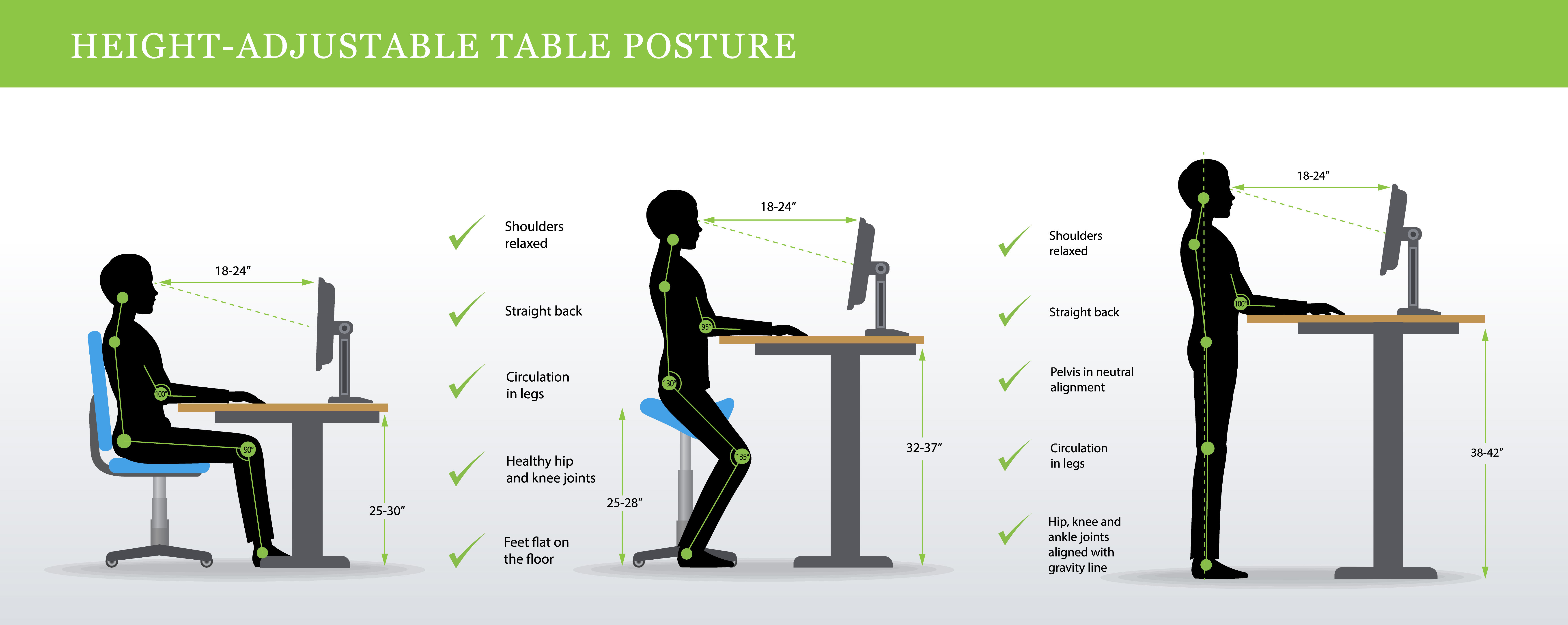The British Chiropractic Association has shockingly revealed that 33% of employees have taken at least one day off work due to back or neck pain last year, with almost half reporting that their pain is triggered by spending long periods of time sitting at their desks. Improve your posture at work has become essential nowadays.
British people spend on average 8.9 hours sitting a day! Not only this but UK workers spend over 82,000 hours at work over their lifetime. Therefore, it is important to know how to improve your posture at work and adopt some simple changes to better your health.
Here are some tips to improve posture:
1. Ask for a workstation assessment from HR
The British Chiropractic Association revealed that just a fifth of the 1,643 workers polled had been offered a desk assessment, ergonomic chairs or laptop stands by their employer to help reduce the level of pain they experienced. If workers use display screen equipment every day for more than an hour, then employers must do a workstation assessment.
The Health and Safety Executive (HSE) states employers must do an assessment when a new workstation is set up, a new user starts work, a change is made to an existing workstation or the way it’s used or when users complain of pain or discomfort.
Therefore, if you are struggling with your posture, speak with your HR department about having a workstation assessment. This can help to improve your posture and make a big difference to your health.
2. Find products to improve your posture at work
There are some really good products out there, which can help protect your body whilst working and minimise back pain.
Here are some ways to correct posture at your desk:
- Standing desks are fantastic for those who suffer from lower back pain. You can switch from sitting to standing through the day. It reduces the strain on your muscles.
- Changing the height of your monitor can have a drastic positive impact on your posture. You can move to whatever is comfortable for you and tweak it throughout the day.
- There are also lots of desk chair accessories that can help to provide better support! They can include lumbar support pillows, angled seat cushions, and wearable devices which correct your body’s alignment and prohibits slouching.
Do you know the danger of prolonged sitting?
3. Make sure you sit correctly
When you are sat at your desk all day, it can become easy to adopt poor posture habits. Most of us will end up slouching, having our legs crossed, leaning over our desk, twisting and turning uncomfortably, sitting for too long in one position, straining your neck to look at the monitor and many more bad habits which contribute to poor desk posture. Sitting correctly is vital to avoiding injuries:
- Ensure your lower back is properly supported
- Rest your feet on the floor
- Place your screen at eye level
- Keep your mouse close
- Avoid screen reflection
- Hold elbows at the sides creating an L-shape in the arms
- Relax the shoulders
- Adjust your chair height so that you can use the keyboard with your wrists and forearms straight and level with the floor
- Avoid phone strain
These tips really help to get better posture at work and can make a difference in your everyday life. Good posture at work also projects a more professional appearance, and by sitting correctly, you can appear more serious and motivated.
4. Position your desk essentials around you
Make sure all of your work essentials are within reach on your desk so that you aren’t awkwardly twisting or turning to grab items. Having to stretch or move in a weird position can place unnecessary strain on your body.
Therefore if you suffer from bad posture or pain it won’t do you any favours. Place your pens, sticky notes, paperwork, phone, computer mouse, keyboard and notepads within reaching distance to improve your posture at work.
5. Stretch your muscles to improve your posture at work
Whilst you are stuck at your desk all day, try to do some desk exercises to stretch your muscles as it wreaks havoc on your posture. Research has also found that regular movement breaks every 30 minutes greatly reduces the health risks posed by sitting.
It’s important to get up and move every now and again, so why not go for a walk to get a drink or go talk to a colleague instead of calling them. You could also suggest having standing meetings as they are more productive and it gets everyone moving.

6. Set reminders
If you struggle to remember to take regular movement breaks, try to set yourself a reminder to get up and move about. A reminder will get you into the habit of taking breaks and getting away from your desk, and eventually, you wouldn’t even need the reminder because it will become a part of your routine. Moving around will really help to improve your posture at work.
There are apps you can download, otherwise you can set reminders on your phone’s alarm, to nudge you to take a break. This will also better your concentration and your general wellbeing.
7. Improve your posture at home
Prevention is always better than cure! You shouldn’t solely focus on improving your posture at work but should focus on strengthening it in your home time.
- Try incorporating regular exercise into your everyday life, with activities like walking, swimming or cycling, as these will keep the muscles around the back to stay strong. They will promote good posture, condition muscles and prevent injuries.
- Strength training and stretching exercises can help to better your posture and core; try planks, squats, lunges, crunches, and wall sits. Pilates is also very good for increasing muscle strength and endurance, improving flexibility and posture, and leading to better balance.
- Good posture involves training your body to stand, walk, sit and lie in positions where the least strain is placed on muscles and ligaments during these activities. Therefore, it takes time to improve your posture and eliminate any bad habits, which have been adopted within the workplace.
Slowly try to incorporate these tips into your everyday life and see whether any muscle or back pain disappears. We spend a large portion of our week at work, which is why it makes it so much more important to take care of your physical health and wellbeing and improve your posture at work.
Read more: How to stay healthy when sitting at a desk all day





